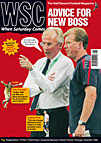 You couldn't avoid seeing the endless plugs for sponsors but, wonders Barney Ronay, did they make you buy anything?
You couldn't avoid seeing the endless plugs for sponsors but, wonders Barney Ronay, did they make you buy anything?
This was surely the most energetically sponsored World Cup yet. Certainly, there was something different about the corporate presence. FIFA and your local TV channel may have long since run out of easy ways to up the logo content. But somehow it was all just a bit more insistent. The pitch perimeter advertising was standardised at this World Cup, with – you’d imagine – each step closer to the holy grail of the halfway line eagerly auctioned off. Close your eyes and you can still picture them all. Hyundai, Toshiba, McDonald’s, Coca-Cola (in Brazil colours). Something called Avaya. At most grounds the advertising boards themselves had either been extended to cover the first couple of rows of seats or framed by a lemon tarpaulin to give them that extra grab factor. These ads were super-sized – bigger and, unless there’s something drastically wrong with the contrast on my television, brighter, too.
Beforehand much was made of the arrival of high definition TV. The tournament’s marketeers would seem to be already wise to the advertising friendly nature of the next generation of viewing experience. In HD you really can see everything. Every strap and tag-line, not to mention every ®, © and ™. At times during the HD World Cup it was difficult to concentrate on the little figures bobbing about on the pitch, what with all the bright, shiny, perfectly pixelated burger suggestions and car-tyre recommendations floating around. Professional football is already a billboard. In the future it looks set to become an even more sophisticated billboard, one whose open spaces are perfectly tailored for the eye-watering, crystal-clear product saturation the HD revolution has in store.
But does it actually do anybody any good? The amounts of money spent by these corporate superpowers to ensure a presence at the top table are, of course, beyond mortal comprehension. Full World Cup privileges will apparently set you back upwards of £15 million a year. Still, it’s hard to imagine the sums can ever add up. Does anyone watching actually think: “Hmm, I really must go out and buy a set of Continental tyres, apply for a Mastercard and maybe pick up one of those Avayas (whatever they may be) while I’m there”?
Amazingly, it seems that the answer is no. They don’t. And nobody really cares anyway. It is an open secret that high-profile brand tie-ins of this sort can never directly repay their cost. It’s all about corporate presence – not so much in a branding sense, as in a “sitting in a glass box, drinking a fine Sancerre and pretending to know who Didier Zokora is” sense. Big corporations like big-money tie-ins with big events such as the World Cup because they like the big perks that come with them. If you were chief executive of a major global lager producer, you’d probably feel you’d earned a couple of weeks watching almost as many World Cup matches as Franz Beckenbauer, occasionally golfing with Michel Platini, not to mention as many complimentary FIFA key fobs as you can stuff into your inside pocket. In the opening round 30 per cent of the crowd in any stadium were either directly or indirectly corporate guests.
This is essentially a global televised event and crowds at games such as these have always been a fairly odd assortment. But still, what a waste of money. Maybe they should have just concentrated on engineering your stereo so that it lasts a little longer, not using hydrogenated vegetable fat in your burger or, even, letting us know what an Avaya actually is. Or maybe just not bothering with all that irritatingly insistent – and commercially unviable – branding in the first place.
From WSC 234 August 2006. What was happening this month